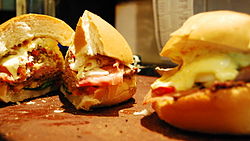 | |
| Type | Sandwich |
|---|---|
| Place of origin | |
| Created by | Antonio Carbonaro [1] |
| Main ingredients | Bun, churrasco beef, bacon, fried or hard-boiled eggs, ham, black or green olives, mozzarella, tomatoes, mayonnaise |


| This article is part of a series on the |
| Culture of Uruguay |
|---|
 |
| Uruguay Portal |
Chivito is the national dish of Uruguay. [2] [3] It is a sandwich of sliced beefsteak ( churrasco ), mozzarella, ham, tomatoes, mayonnaise and black or green olives. A chivito commonly also includes bacon and fried or hard-boiled eggs. It is served in a bun, often accompanied by French-fried potatoes. [4] [5] Other ingredients, such as red beets, peas, grilled or pan-fried red peppers, and slices of cucumber, may be added. [6] [7]
Contents
In Argentine cuisine a similar sandwich is called lomito.
